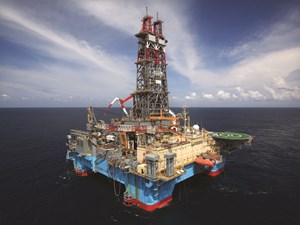Equally impressive: Maersk Discoverer drills in shallow waters
COPENHAGEN -- Did you know that on a deepwater rig it is just as challenging to drill in shallow water as in very deep water?
On Oct. 2, 2017, Maersk Discoverer moved the boundaries for drilling in shallow waters when successful drilling operations commenced in 285 meters water depth. This is the shallowest water drilling operation in Dynamic Positioning mode ever conducted for both Maersk Drilling and for client BP, and constitutes another operational highlight for Maersk Drilling.
“Well done to everyone involved with this operation,” says Angela Durkin, COO of Maersk Drilling. “This is another example of achieving operational excellence by working together across departments within Maersk Drilling.”
In 2015, BP asked Maersk Drilling if it was possible for Maersk Discoverer to drill a well in only 408-m water depth. Normally, Maersk Drilling’s deepwater rigs are designed to operate in water depths as shallow as 460 m, and as deep as 3,050 m in Dynamic Positioning mode.
The gain for the client was that it would save costs and rig time associated with mooring. After a suitable risk assessment, the well was safely and efficiently drilled, completing the 408-m operation.
A greater challenge
After this success, BP returned with an even greater challenge: Drill a well in 285-m water depth in Dynamic Positioning mode.
“Initially, it seemed too great a challenge,” says Allan McColl, Rig Leader on Maersk Discoverer. “It was paramount that we ensured safe operations, even in such shallow waters.”
To assess the risk of the operation, McColl and his local Cairo rig team enlisted the support of Technical Organization. “After working closely with our Technical Organization, we were able to return to the customer with the good news that we could in fact drill the well.”
The second phase: Ensuring safe execution
But then the client added another challenge: Drilling in Dynamic Positioning mode in 285-m water depth with a window of time that covered the highest number of months possible.
With further TO support, and with detailed analysis of conditions, it was established that drilling operations would be possible in the months of May through October. To verify this conclusion, a major risk assessment, facilitated by the TO Technical Safety Department, was begun. “In the end,” says McColl, “the proper risk management steps ensured us of a successful outcome.”
The result: A happy customer
The operation can now report that the well has been successfully drilled with no non-productive time associated with rig positioning. The rig left location on Oct. 15 and moved on to drill in comparatively deep water, with a depth of 388 m.
“But the story does not quite end there,” says McColl, and stresses the importance of the money saved for the client. “We have saved our customer time and money by operating in Dynamic Positioning mode, compared to mooring the rig to drill and run completions on three wells. That is something we can be proud of. This cooperation has moved boundaries within our business – and, on top of that, produced a happy customer.”



